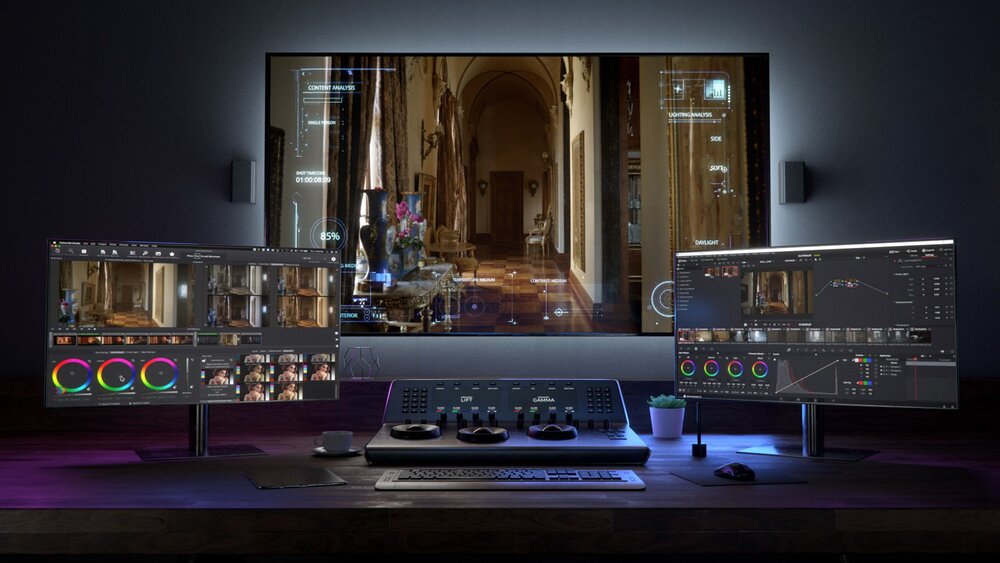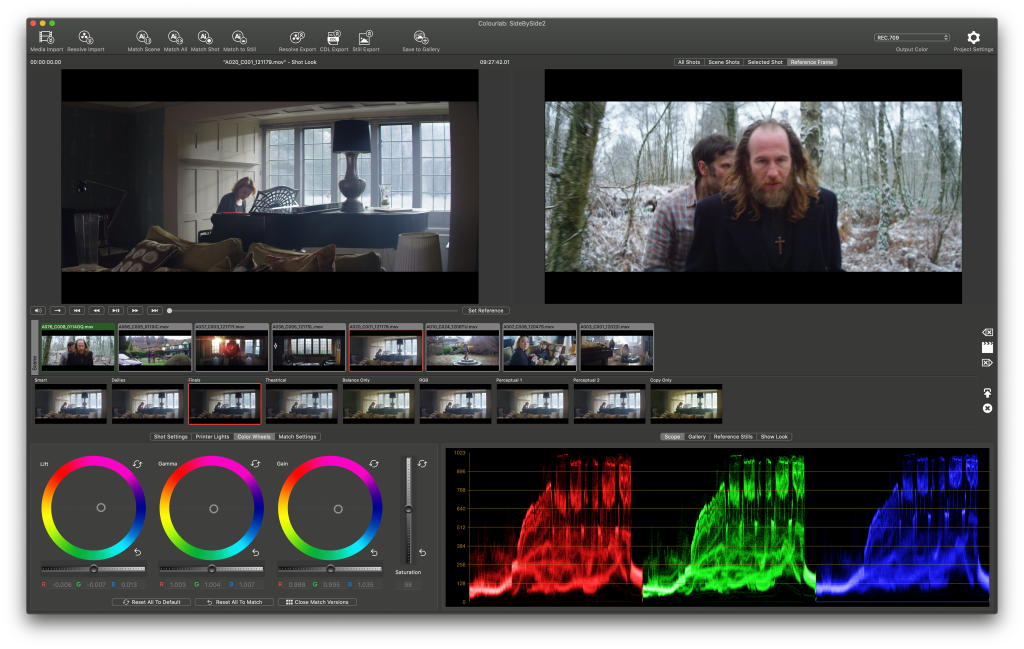Hollywood-quality color grading is about to get way more accessible, affordable, and automated. It’s all thanks to a fresh collaboration between experts in AI and live visual software – and studio colorists. The result promises to be a huge deal for anyone working with color in moving images.
The pitch is all about AI. But the upshot is, you can do automated color correction on a bunch of clips. You can keep your brain on the video production stuff, instead of sucking your entire life into manual color grading.
And this didn’t come about because of a bunch of machine intelligence. It started with some human brains finally coming together.
Human intelligence as well as “artificial”
Hollywood and the underground visualist scene haven’t met all that often. But as you look at this team, the combination makes loads of sense. The kinds of people who work in VJ software and open visual tech are experienced in the bleeding edge tech, plus how to make complex processes live and immediate. And they’ve figured out how to package that power so mortal users can understand it. Hollywood pros understand the demands of precise color and cinematic quality, the brutal rigors of industrial workflows, and no-compromise output.
I mean, all of that sounds good on paper. The trick is actually putting those different cultures together. But it’s about time Hollywood figured out the underground had the kind of tools they needed. And in this age of rapid content production, it’s about time to take those industrial-grade color tools and give them to more people – just as has happened with cameras and editing tools.
So, here are the players:
Vidvox, makers of VDMX and cutting-edge 3D-accelerated and open source visual tools, specializing in the Mac. (This is a macOS product, as you’ll see.)
Vade, aka Anton Marini, artist/developer (and long-time Vidvox collaborator) who pioneered tools like Syphon (routing visual textures between Mac apps) and Synpsosis and CinemaNet. That last one is important – think machine learning, neural net-powered cinematic datasets and tools for managing and analyzing media. So there’s some of the AI in Colourlab AI.
Color Intelligence is a high-end studio consulting on image processing, with color scientist Dado Valentic plus industry pros Mark L. Pederson and Steve Bayes. Their clients already included Warner Brothers, HBO, Netflix, NBC Universal, and CBS. Now that client roster might just add, like… you.
Mr. Valentic alone has colorist credits on the likes of Total Recall (2012), Sherlock Holmes: A Game of Shadows, Exodus: Gods and Kings, and … well, you can read his IMDB. But the expertise here in color science and image processing sets itself out from anything in the industry.

The software
Okay, that was a lot of information. The beauty of this software, though, is that it’s simple.
You drop in movies, make a color correction, set a reference frame to the grading you’re happy with – and then the software will match everything else to that. That leaves you free to tweak things later, of course, but it takes out the grunt work where your eyes usually fall out.
All you need is a Mac with a decent GPU and you’re off to the races. It integrates directly with the Mac platform and Apple tools, as well as with the increasingly popular DaVinci Resolve from Blackmagic.
Oh yeah, about cost – well, Resolve you can get for free (or $299 for the studio version). Early access software will cost just US$99 for a full year. (After that, it’ll be $99 a month for the full pro-level version – but hey, one gig will get you up and running with that, and that’s for the version with all the bells and whistles.) So all of this may have just changed the value proposition of the Mac.
Steve Bayes who was an Apple Pro Video Product Manager was even an angel investor. It evidently makes use of a lot of Apple tech.
Redshark has a great writeup that cuts straight to how major this is:
Colourlab Ai: This is the most revolutionary software since colour grading was invented [Redshark]
Well… yeah.
See also this nice writeup by CineD:
Colourlab Ai – Color Grading with Artificial Intelligence


Here’s how Vidvox describes it – more details soon, as they become available:
Colourlab Ai makes it easy to automatically color match footage for a project from a graded clip or reference image, instantly matching scenes across an edited timeline or matching hours of dailies. The Colourlab Ai smart matching system eliminates the manual and tedious aspects of the color grading process, empowering filmmakers and colorists to focus more on the creative parts of their job.
Rather than rendering color into a timeline, Colourlab Ai acts as your personal assistant, presenting its proposed adjustments in the form of non-destructive metadata settings, as the industry standard familiar controls of ASC CDLs, Lift Gamma Gain or even Printer Lights. This approach allows colorists, cinematographers, and content creators to continue making subjective and creative adjustments throughout the post production process.
Official release in October, but there’s a preview release now.
Eventually, this will cost you US$99/mo – though if you’re getting regular gigs, that could pay for itself easily. (That also evidently represents a top tier; we’ll see if there’s an entry level price tier.)
But with the pre-release, you’ll get a full year for just a hundred bucks.
So where does AI come in?
“AI” gets mentioned a lot – not only in the name, but throughout the marketing. What does that actually mean here, though?
Unfortunately, “artificial intelligence” has come to mean science fiction-style general intelligence to a lot of the population. But to data scientists, AI can include various machine learning techniques that are far more specific.
And what Colourlab Ai appears to be doing is where today’s machine learning really excels. AI is very effective at processing large amounts of data quickly, in ways that can be trained to be more accurate than just applying heuristic rules and traditional statistical averaging. We’re also getting to the point where processing this data in parallel is working better – and Apple (like some other vendors) have been working hard on accelerating image processing, display, and machine learning tasks on the GPU and specialized chips. (You might wind up running this tool on Apple Silicon, I would imagine.)
That’s no small trick, because when applied properly, the software better matches your human expectations and perception.
The developers aren’t talking much about the specifics, but it’s worth looking back at Vade’s past projects. Synopsis and CinemaNet seem almost certainly to be involved in what makes Colourlab Ai so usable. That includes some non-AI bits, like all these media management tools. But it’s worth checking out how Vade used pre-trained datasets to analyze media in a way that seems cinematography-informed to humans.

We could also be seeing another example of open source tech working well with commercialized products. CinemaNet and its data set are open source and community-based. That also opens up the possibility that users can work to remove bias in the data. At the same time, the productized, end user-friendly side of this being commercial is important, too. It also has the not-incidental side effect of being able to pay bills for developers like Anton and David Lublin of Vidvox. But that keeps development independent.
Consider that the model has often been the inverse. If open-source developers and AI researchers have to rely exclusively on big patrons like Google and Microsoft, then control of the data sets – and their bias – also remain with those big tech companies. There’s also less chance for specialized products that serve needs like the pro colorist market.
I’m very curious to see how this might evolve. In creative technology, I think we benefit greatly when advanced users support independent products, and aren’t constrained by either just giving away their stuff for free or having to cater only to average, passive consumers. So there’s a compelling business model here – and one that shows some of the ways machine learning could go in the near future.
Oh, and – come on. I definitely want to do color grading this way, and I’m a musician.
Watch this space.
For more:
Colourlab Ai – Your personal professional color correction assistant for the Mac – Coming October 2020 [Vidvox Blog]
And the official site: